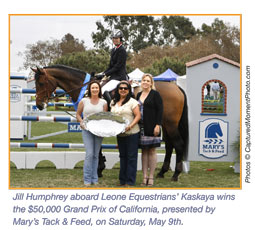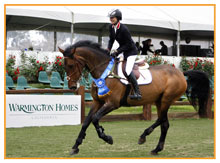By Laura Ware
Back in October of 2008 I was excited to read that the USHJA was creating the Emerging Athlete’s Program (EAP). Geared towards discovering and teaching young people who are dedicated to becoming the best riders and horsemen possible, I was happy it began while I was still young enough to participate. The application, which I eagerly completed, contained questions about academics, extracurricular activities, and riding accomplishments. I was thrilled to be chosen to participate in the 3’6” section on my young jumper Westin.
The clinic, given by Melanie Smith Taylor, was split into three sections: 3’, 3’6”, and 4’, with no more than eight riders each. The first day, we did trot rails, a circle of four jumps, and a relatively straightforward course. The trot rails were spaced one step, two steps, then one step apart, and the circle of jumps was set so the rider could put either two or three strides between the fences, which were actually just small flower boxes with potted plants as standards. Melanie really focused on increasing our awareness of our horse’s feet. She had us do an exercise where we would back up four steps, go forward four steps, and then decrease the amount of steps until we were just shifting our horse’s weight forward and backwards, without actually moving their feet. The idea was that this shifting of our horse’s weight at the halt would be similar to the feeling of rebalancing our horses back over their hindquarters while cantering on course.
The second day, the exercises were more technically challenging and Melanie was a bit more demanding. I loved it. Of course, I had my fair share of problems, but I learned so much about what I need to do to improve myself and my horse, and being able to figure my way out of some of the problems presented improved my confidence in my riding abilities. Similar to the first day, we did more trot and canter rails – Melanie had been unimpressed with our performance over the trot cavaletti the previous day. We also practiced exercises that forced us to dramatically lengthen and shorten our horse’s stride. In our flatwork, we cantered over a long bounce to a short bounce at one end of the ring, to a short one stride to a long one stride, all ground rails, at the other end. During the 3’ session, I stood next to the rails so I could re-position them as the horses displaced them, and I felt bad every time I had to close the gap between them – they were set so short! Though Westin had been really good with the trot rails, we had some problems with the cantering elements. He wasn’t keen on the idea of putting his feet between such closely placed poles – he found it much easier to just take one big, awkward leap over them! However, after a few corrections, he figured out how short he needed to make his stride, and did the exercise quite well.
 Over the jumps, we practiced long gallops to singles, accompanied with short turns. Melanie instructed us to ride to each fence with a particular distance so the task upon landing would be easier to accomplish. The amount of discipline the lesson demanded was starting to wear on Westin and at times he became a little resistant, but overall he performed well over the jumps. It was fun being able to gallop down to a single oxer, and then do a pretty prompt turn right afterwards, which six months ago Westin probably couldn’t have done. Immediately after our last jumping pattern, Melanie asked us to do a small movement to keep our horses thinking. She asked me to place my horse’s front feet one step to the right, without moving his hind end. Westin wanted nothing to do with this! He threw a small temper tantrum as Melanie was going on about how none of the riders in my generation are able to do something as simple as place their horse’s feet, and I was really starting to sweat. “How do you expect to adjust for a distance if you can’t even move your horse’s feet at the halt?” she asked us emphatically. A little light illuminating the significance of flatwork went on in my head. I’d never thought of this, and I was frustrated with myself for not being able to do something so simple. She continued explaining this particular failing to me as well as the rest of the group, even using her pen to demonstrate my incorrect turn effort. Just when it seemed she was going to give up on me and continue with the clinic, I thought to myself, “Westin, you are going to participate” and sure enough, he did and we did it! Being able to move my horse’s hooves one step to the right may not seem like a great achievement, but I was proud of both of us for finally figuring it out. Though I had to take some heat for being unable accomplish the task initially, I was truly pleased with our eventual success.
Over the jumps, we practiced long gallops to singles, accompanied with short turns. Melanie instructed us to ride to each fence with a particular distance so the task upon landing would be easier to accomplish. The amount of discipline the lesson demanded was starting to wear on Westin and at times he became a little resistant, but overall he performed well over the jumps. It was fun being able to gallop down to a single oxer, and then do a pretty prompt turn right afterwards, which six months ago Westin probably couldn’t have done. Immediately after our last jumping pattern, Melanie asked us to do a small movement to keep our horses thinking. She asked me to place my horse’s front feet one step to the right, without moving his hind end. Westin wanted nothing to do with this! He threw a small temper tantrum as Melanie was going on about how none of the riders in my generation are able to do something as simple as place their horse’s feet, and I was really starting to sweat. “How do you expect to adjust for a distance if you can’t even move your horse’s feet at the halt?” she asked us emphatically. A little light illuminating the significance of flatwork went on in my head. I’d never thought of this, and I was frustrated with myself for not being able to do something so simple. She continued explaining this particular failing to me as well as the rest of the group, even using her pen to demonstrate my incorrect turn effort. Just when it seemed she was going to give up on me and continue with the clinic, I thought to myself, “Westin, you are going to participate” and sure enough, he did and we did it! Being able to move my horse’s hooves one step to the right may not seem like a great achievement, but I was proud of both of us for finally figuring it out. Though I had to take some heat for being unable accomplish the task initially, I was truly pleased with our eventual success.
The end result of the EAP annually is that the pool of riders chosen from each zone will be narrowed down, after more training sessions and a Nation’s Cup-style competition, until there are just two, and the top two will each receive a grant for one month’s worth of training with a particular professional. Through this experience I gained perspective, learned a lot and came home motivated with some new exercises to practice. EAP provides a unique chance for young competitors to learn from top professionals and grow as riders. If you’re under 21 and aspire to be the best rider possible – I highly recommend that you apply for the 2010 program.
 Palacios left no room for error, keeping riders on their toes from the first turn to the last line. Although the rollback turn from one to two seemed straight forward, it was the initial spot where time was wasted and often could not be made up later in the course. The last line paralleled the in-gate in a steady seven strides to a triple that rode long in one to a sizeable gate oxer to another long two stride followed by a turn away from the in-gate to a big square oxer. The first rider to negotiate the course without a rail went fifth in the line-up, Gretchen Lof aboard Zambezi (Kings Wood Farm, LLC). However she stopped the clock at 79.41 resulting in three time faults, and a fifth place finish. Following her round, one or more rails dropped and time faults accrued until the twenty-second pair, Will Simpson aboard Nadia (Gotham Enterprises, LLC), galloped through the timers completely clean. Shortly after, Jill Humphrey and Kaskaya (Leone Equestrians Inc.) did the same. Twenty-ninth in the ring, Guy Thomas and Urian (Vicki Juelsgaard), joined the jump-off participants and not until the thirty-ninth horse, Veronica Tracy on her mount Muscadet De La Saveniere, did we have the fourth clean ride.
Palacios left no room for error, keeping riders on their toes from the first turn to the last line. Although the rollback turn from one to two seemed straight forward, it was the initial spot where time was wasted and often could not be made up later in the course. The last line paralleled the in-gate in a steady seven strides to a triple that rode long in one to a sizeable gate oxer to another long two stride followed by a turn away from the in-gate to a big square oxer. The first rider to negotiate the course without a rail went fifth in the line-up, Gretchen Lof aboard Zambezi (Kings Wood Farm, LLC). However she stopped the clock at 79.41 resulting in three time faults, and a fifth place finish. Following her round, one or more rails dropped and time faults accrued until the twenty-second pair, Will Simpson aboard Nadia (Gotham Enterprises, LLC), galloped through the timers completely clean. Shortly after, Jill Humphrey and Kaskaya (Leone Equestrians Inc.) did the same. Twenty-ninth in the ring, Guy Thomas and Urian (Vicki Juelsgaard), joined the jump-off participants and not until the thirty-ninth horse, Veronica Tracy on her mount Muscadet De La Saveniere, did we have the fourth clean ride. Four-faulters placed sixth through twelfth; the top of that pack was Susie Hutchison on Cantano (El Dorado 29) who went lightning fast with just one rail. Third time in the ring was a charm for Guy Thomas when clean aboard Urian, having his share of ups and downs with four entries including a fall off Midnight Dance (Alec Lawler), one rail on Carino (Willow Tree Farm, Inc.), and just one rail on Peterbilt (Peterbilt, LLC). Although possibly a touch sore on Sunday, Saturday was still worth celebrating for Thomas and Willow Tree, finishing with three in the top twelve (see results below).
Four-faulters placed sixth through twelfth; the top of that pack was Susie Hutchison on Cantano (El Dorado 29) who went lightning fast with just one rail. Third time in the ring was a charm for Guy Thomas when clean aboard Urian, having his share of ups and downs with four entries including a fall off Midnight Dance (Alec Lawler), one rail on Carino (Willow Tree Farm, Inc.), and just one rail on Peterbilt (Peterbilt, LLC). Although possibly a touch sore on Sunday, Saturday was still worth celebrating for Thomas and Willow Tree, finishing with three in the top twelve (see results below).